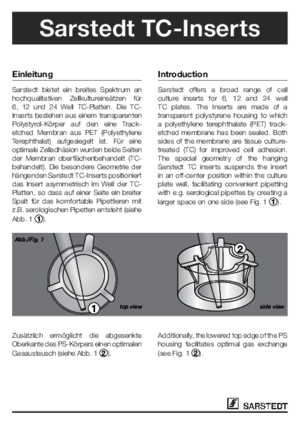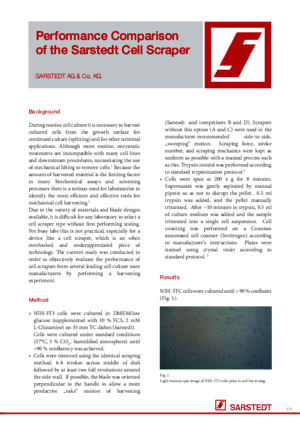
Ready. Set. Grow.
Ready. Set. Grow.
Language:
A basic requirement for the successful cultivation of cells in vitro is to simulate the in vivo environment of the relevant cell type as accurately as possible. For cell culture cells, the surface condition of the culture vessel is particularly important because many cell types can only survive, proliferate and differentiate following successful adhesion. In order to meet the requirements for as many different cell types as possible, we offer colour-coded flasks, dishes and plates with three different growth surfaces – adherent, sensitive adherent and suspension.
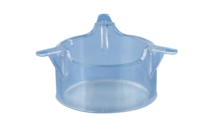
TC insert, for 6-well plates, membrane: PET, translucent, pore size: 8 µm, sterile, non-pyrogenic/endotoxin-free, non-cytotoxic, 1 piece(s)/blister

TC insert, for 12-well plates, membrane: PET, translucent, pore size: 0.4 µm, sterile, non-pyrogenic/endotoxin-free, non-cytotoxic, 1 piece(s)/blister

TC insert, for 12-well plates, membrane: PET, transparent, pore size: 0.4 µm, sterile, non-pyrogenic/endotoxin-free, non-cytotoxic, 1 piece(s)/blister
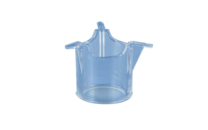
TC insert, for 12-well plates, membrane: PET, transparent, pore size: 1 µm, sterile, non-pyrogenic/endotoxin-free, non-cytotoxic, 1 piece(s)/blister

TC insert, for 12-well plates, membrane: PET, translucent, pore size: 3 µm, sterile, non-pyrogenic/endotoxin-free, non-cytotoxic, 1 piece(s)/blister

TC insert, for 12-well plates, membrane: PET, translucent, pore size: 5 µm, sterile, non-pyrogenic/endotoxin-free, non-cytotoxic, 1 piece(s)/blister
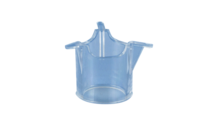
TC insert, for 12-well plates, membrane: PET, translucent, pore size: 8 µm, sterile, non-pyrogenic/endotoxin-free, non-cytotoxic, 1 piece(s)/blister
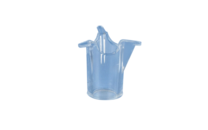
TC insert, for 24-well plates, membrane: PET, translucent, pore size: 0.4 µm, sterile, non-pyrogenic/endotoxin-free, non-cytotoxic, 1 piece(s)/blister

TC insert, for 24-well plates, membrane: PET, transparent, pore size: 0.4 µm, sterile, non-pyrogenic/endotoxin-free, non-cytotoxic, 1 piece(s)/blister

TC insert, for 24-well plates, membrane: PET, transparent, pore size: 1 µm, sterile, non-pyrogenic/endotoxin-free, non-cytotoxic, 1 piece(s)/blister

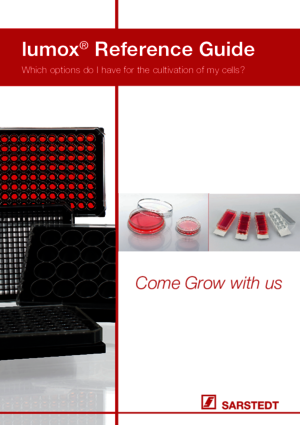
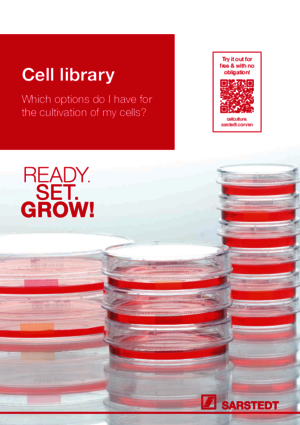
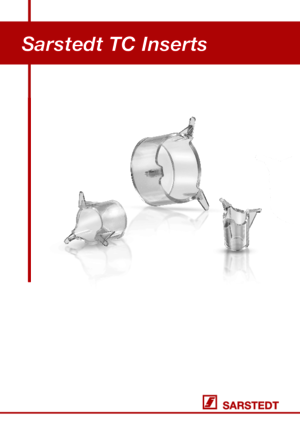



We offer cell culture tubes in sizes T-25, T-75 and T-175.
We have dishes with diameters of 35 mm, 60 mm, 100 mm and 150 mm.
For multiple cultivation on an average to small scale, we offer tissue culture plates with 6, 12, 24, 48 and 96 wells.
In general, our cell culture products can be coated without any problems. In addition to the standard cell culture surface for adherent cells (red colour code), we also offer an additional service for sensitive, adherent cells (e.g. primary cells, cells under serum-reduced conditions). Polar groups are also brought into the hydrophilic surface via a special treatment of the plastic surface. This leads to improved imitation of the in vivo environment and therefore to the adhesion of challenging cells. Due to its properties, the Cell+ surface (yellow colour code) can make the use of coated culture vessels redundant in many cases.
All tissue culture bottles are equipped with a user-friendly quick-release cap which is available either as a ventilation cap or a two-position screw cap.
The coloured marking on the cell culture bottles, dishes and plates represents the surface of the cell culture tube. In order to meet the requirements for as many different cell types as possible, we offer flasks, dishes and plates with three different growth surfaces:
- Red: The hydrophilic standard growth surface provides an optimum culture substrate for the most adherent cells.
- Yellow: The yellow Cell+ growth surface was developed for particularly sensitive adherent cells (e.g. primary cells, sensitive cell culture lines and cells which are cultivated under serum-reduced/serum-free conditions). Due to its properties, the Cell+ surface can make the use of coated culture vessels redundant in many cases.
- Green: We have a hydrophobic growth surface for suspension cells. The hydrophobic surface is particularly suitable for the cultivation of suspension cells and minimises cell losses during the sub-cultivation due to unwanted microadhesion.
